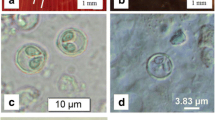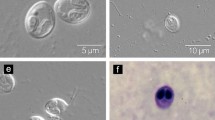Abstract
In a parasitological survey of freshwater fishes near Meerut, Uttar Pradesh, India, myxozoan infections in Pabdah catfish Ompok pabda Ham. (Siluriformes: Siluridae) were found. Round plasmodia and scattered spores of Myxobolus ompok n. sp. were found in the kidney of the host. Plasmodia measuring 150–200 μm were located in the renal interstitium. Spores of Myxobolus ompok n. sp. were elongated pyriform, 13.6–14.4 (14.8 ± 0.42) μm long, 5.6–6.4 (6.5 ± 0.33) μm wide, and 5.2–6.4 (5.9 ± 0.43) μm thick with two equal polar capsules measuring 8.0–8.5 (8.2 ± 0.2) μm in length and 1.5–2.4 (1.8 ± 0.33) in width having six filamental turns. Both the morphology and DNA analysis of the 18S rRNA gene revealed that Myxobolus ompok n. sp. is distinct from previously described species of Myxobolus and shares no significant similarity with any other Myxobolus deposited in the GenBank database. Phylogenetic analysis inferred that this species showed the closest similarity to Myxobolus miyarii (KT001495). This is the first record of any Myxobolus sp. from O. pabda in India.




Similar content being viewed by others
References
Adriano EA, Carriero MM, Maia AAM, Silva MRM, Naldoni J, Ceccarelli PS, Arana S (2012) Phylogenetic and host-parasite relationship analysis of Henneguya multiplasmodialis n. sp. infecting Pseudoplatystoma spp. in Brazilian Pantanal wetland. Vet Parasitol 185:110–120. https://doi.org/10.1016/j.vetpar.2011.10.008
Atkinson SD, Banner CR (2017) A novel myxosporean parasite Myxobolus klamathellus n. sp. (Cnidaria: Myxosporea) from native blue chub (Gila coerulea) in Klamath Lake, Oregon. Parasitol Res 116:299–302. https://doi.org/10.1007/s00436-016-5292-y
Banik S, Malla S (2011) Habitat mapping for Ompok pabda (Hamilton-Buchanan, 1822) in Gomoti River of Tripura. Proceedings of the 10th Agricultural Science Congress, February 10–12, 2011, Lucknow India. National Bureau of Fish Genetic Resources (ICAR), Lucknow, p 388
Barta JR, Martin DS, Liberator PA, Dashkevicz M, Anderson JW, Feighner SD, Elbrecht A, Perkins-Barrow A, Jenkins MC, Danforth HD, Ruff MD, Profous-Juchelka H (1997) Phylogenetic relationships among eight Eimeria species infecting domestic fowl inferred using complete small subunit ribosomal DNA sequences. J Parasitol 83:262–271
Carriero MM, Adriano EA, Silva MRM, Ceccarelli PS, Maia AAM (2013) Molecular phylogeny of the Myxobolus and Henneguya genera with several new South American species. PLoS One 8:e73713. https://doi.org/10.1371/journal.pone.00737131-12
Cech G, Borzák R, Molnár K, Székely C (2015) Three new species of Myxobolus Bütschli, 1882 (Myxozoa: Myxobolidae) infecting the common nase Chondrostoma nasus (L.) in the River Danube. Syst Parasitol 92:101–111. https://doi.org/10.1007/s11230-015-9589-5
Chakrabarti NM, Chakrabarti PP, Mondal SC (2007) Artificial breeding seed production and rearing of butter fish Ompok pabda—a significant mile stone in technology advancement. Fishing Chimes 26:134–136
Eiras JC, Molnár K, Lu YS (2005) Synopsis of the species of Myxobolus Bütschli, 1882 (Myxozoa: Myxosporea: Myxobolidae). Syst Parasitol 61:1–46. https://doi.org/10.1007/s11230-004-6343-9
Eiras JC, Zhang JY, Molnár K (2014) Synopsis of the species of Myxobolus Bütschli, 1882 (Myxozoa: Myxosporea: Myxobolidae) described between 2005 and 2013. Syst Parasitol 88:11–36. https://doi.org/10.1007/s11230-014-9484-5
Eszterbauer E (2004) Genetic relationship among gill-infecting Myxobolus species (Myxosporea) of cyprinids: molecular evidence of importance of tissue-specificity. Dis Aquat Org 58:35–40
Eszterbauer E, Székely C (2004) Molecular phylogeny of the kidney-parasitic Sphaerospora renicola from common carp (Cyprinus carpio) and Sphaerospora sp. from goldfish (Carassius auratus auratus). Acta Vet Hung 52:469–478
Fiala I, Bartošová-Sojková P, Whipps CM (2015) Classification and phylogenetics of Myxozoa. In: Okamura B, Gruhl A, Bartholomew JL (eds) Myxozoan evolution, ecology and development. Springer International Publishing Cham, Basel, pp 85–110
Hallet SL, Diamant A (2001) Ultrastructure and small subunit ribosomal DNA sequence of Henneguya lesteri n. sp. (Myxosporea), a parasite of sand whiting Sillago analis (Sillaginidae) from the coast of Queensland. Australia. Dis Aquat Org 46:197–212
Jayaram KC (1999) Freshwater fishes of Indian region. Narendra Publishing House, New Delhi
Jhingran VG (2004) Fish and fisheries of India. Reprint edition. Daya Publisher, Delhi
Kaur H, Attri R (2015) Morphological and molecular characterization of Henneguya bicaudi n. sp. (Myxosporea: Myxobolidae) infecting gills of Cirrhinus mrigala (Ham.) in Harike Wetland, Punjab (India). Parasitol Res 114:4161–4167
Kent ML, Andree KB, Bartholomew JL, El-Matbouli M, Desser SS, Devlin RH, Feist SW, Hedrick RP, Hoffmann RW, Khattra J, Hallett SL, Lester RJG, Longshaw M, Palenzeula O, Siddall ME, Xiao C (2001) Recent advances in our knowledge of the Myxozoa. J Eukaryot Microbiol 48:395–413
Liu Y, Whipps CM, Gu ZM, Zeng LB (2010) Myxobolus turpisrotundus (Myxosporea: Bivalvulida) spores with caudal appendages: investigating the validity of the genus Henneguya with morphological and molecular evidence. Parasitol Res 107:699–706. https://doi.org/10.1007/s00436-010-1924-9
Liu XH, Batueva MD, Zhao YL, Zhang JY, Zhang QQ, Li TT, Li AH (2016) Morphological and molecular characterisation of Myxobolus pronini n. Sp. (Myxozoa: Myxobolidae) from the abdominal cavity and visceral serous membranes of the gibel carp Carassius auratus gibelio (Bloch) in Russia and China. Parasit Vectors 9:562. https://doi.org/10.1186/s13071-016-1836-3
Lom J, Arthur JR (1989) A guideline for preparation of species description in Myxosporea. J Fish Dis 12:151–156
Marcotegui P, Martorelli S (2017) Myxobolus saladensis sp. nov., a new species of gill parasite of Mugil liza (Osteichthyes, Mugilidae) from Samborombón Bay, Buenos Aires, Argentina. Iheringia Sér Zool 107:1–5. https://doi.org/10.1590/1678-4766e2017026
Milne I, Lindner D, Bayer M, Husmeier D, McGuire G, Marshall DF, Wright F (2008) TOPALi v2: as rich graphical interface for evolutionary analyses of multiple alignments on HPC clusters and multicore desktops. Bioinformatics 25:126–127. https://doi.org/10.1093/bioinformatics/btn575
Molnár K (2007) Site preference of myxozoans in the kidneys of Hungarian fishes. Dis Aquat Org 78:45–53. https://doi.org/10.3354/dao01827
Molnár K, Eszterbauer E, Székely C, Dán Á, Harrach B (2002) Morphological and molecular biological studies on intramuscular Myxobolus spp. of cyprinid fish. J Fish Dis 25:643–652
Molnár K, Eszterbauer E, Marton S, Cech G, Székely C (2009) Myxobolus erythrophthalmi sp. n. and Myxobolus shaharomae sp. n. (Myxozoa: Myxobolidae) from the internal organs of rudd, Scardinius erythrophthalmus (L.), and bleak, Alburnus alburnus (L.). J Fish Dis 32:219–231. https://doi.org/10.1111/j.1365-2761.2008.00976.x
Moreira GSA, Adriano EA, Silva MRM, Ceccarelli PS, Maia AAM (2014) The morphological and molecular characterization of Henneguya rotunda n. sp., a parasite of the gill arch and fins of Salminus brasiliensis from the Mogi Guaçu River, Brazil. Parasitol Res 113:1703–1711. https://doi.org/10.1007/s00436-014-3815-y
Pillay TVR (2000) Aquaculture—principles and practices. Fishing News Books, Cambridge
Rosser TG, Baumgartner WA, Barger MA, Griffin MJ (2017) Myxobolus lepomis n. sp. (Cnidaria: Myxobolidae), a gill myxozoan infecting Lepomis marginatus Holbrook and Lepomis miniatus Jordan (Perciformes: Centrarchidae), in the Big Thicket National Preserve, Texas, USA. Syst Parasitol 94:535–545. https://doi.org/10.1007/s11230-017-9719-3
Siddiqua KA, Islam MS, Hossain MG, Ahmed ATA (2000) A histological study of the spermatogenesis in Ompok pabda (Hamilton-Buchanan, 1822). Bangladesh J Fish Res 4:185–189
Székely C, Cech G, Chaudhary A, Borzák R, Singh HS, Molnár K (2015) Myxozoan infections of the three Indian major carps in fish ponds around Meerut, UP, India, with descriptions of three new species, Myxobolus basuhaldari sp. n., M. kalavatiae sp. n. and M. meerutensis sp. n., and the redescription of M. catlae and M. bhadrensis. Parasitol Res 114:1301–1311. https://doi.org/10.1007/s00436-014-4307-9
Tamura K, Stecher G, Peterson D, Filipski A, Kumar S (2013) MEGA6: molecular evolutionary genetics analysis version 6.0. Mol Biol Evol 30:2725–2729. https://doi.org/10.1093/molbev/mst197
Thompson JD, Higgins DG, Gibson TJ (1994) CLUSTAL W: improving the sensitivity of progressive multiple sequence alignment through sequence weighting, position-specific gap penalties and weight matrix choice. Nucleic Acids Res 22:4673–4680
Zhang B, Zhai Y, Liu Y, Gu Z (2017) Myxobolus pseudowulii sp. n. (Myxozoa: Myxosporea), a new skin parasite of yellow catfish Tachysurus fulvidraco (Richardson) and redescription of Myxobolus voremkhai (Akhmerov, 1960). Folia Parasitol 64. https://doi.org/10.14411/fp.2017.030
Acknowledgements
The authors thank the Head of the Department of Zoology, Chaudhary Charan Singh University, Meerut, Uttar Pradesh, India, for providing laboratory facilities. AG thanks the Head, Department of Zoology, D.N.P.G. College, Meerut, Uttar Pradesh, India. We are grateful to Ms. Györgyi Ostoros for the histological work and the drawings.
Funding
The work was supported by the grant from UGC (University Grants Commission) India, under the Post-Doctoral Fellowship [F.15-191/2012 (SA-II)] to AC and was also supported by the European Regional and Development Fund and the Government of Hungary within the project GINOP-2.3.2-15-2016-00025.
Author information
Authors and Affiliations
Corresponding author
Ethics declarations
No permit for the use of animals needed—marketed fish were purchased at the local fish market.
Conflict of interest
The authors declare that they have no conflict of interest.
Rights and permissions
About this article
Cite this article
Chaudhary, A., Goswami, U., Gupta, A. et al. Morphological, histological, and molecular description of Myxobolus ompok n. sp. (Myxosporea: Myxobolidae), a kidney myxozoan from Pabdah catfish Ompok pabda (Hamilton, 1822) (Siluriformes: Siluridae) in India. Parasitol Res 117, 1899–1905 (2018). https://doi.org/10.1007/s00436-018-5882-y
Received:
Accepted:
Published:
Issue Date:
DOI: https://doi.org/10.1007/s00436-018-5882-y




